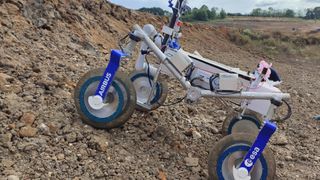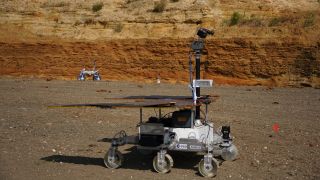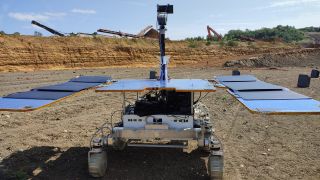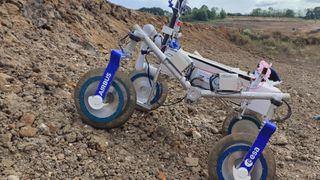European aerospace giant Airbus has taken two of its Mars rovers out for field tests in a quarry near London, showcasing for the first time a new robotic arm for autonomous sample collection on alien planets. The company also experimented with a model of its ExoMars rover, hoping to improve its navigation system to enable the robot to travel faster and explore more terrain once it reaches the Red Planet in 2028.
During the tests, the Mars Sample Fetch Rover demonstrator model named Codi received coordinates from a simulated ground control station to direct it to where simulated Mars samples had been stashed. The rover then used its onboard maps and an autonomous navigation system that includes a pair of stereo cameras to find its way to the samples.
Airbus has already tested the rover twice in the same quarry in recent years, but this year’s test campaign was the first to demonstrate not only travel but also sample collection. That, too, had to be done completely autonomously.

The rover moves at a leisurely speed of about 2.75 inches per second (7 centimeters per second), while also making frequent stops to evaluate the surrounding terrain with its stereo cameras and decide on the safest and most efficient route. During the tests, the rover was able to cover relatively large distances without any human intervention. “We hit a record of 300 meters [980 feet] that the rover managed to do in a day, all on its own, no interruptions,” Chris Draper, Exploration Rover Program Manager at Airbus told Space.com.
The Sample Fetch Rover, in development since 2018, was intended to travel to Mars in 2026 to retrieve samples collected by NASA’s Perseverance rover. In 2022, NASA scrapped the fetch rover due to budget cuts and opted to use Perseverance instead.
The European Space Agency, however, chose to continue with the development, hoping to use the technology in a future mission, perhaps on the moon.
“The building blocks are — being able to autonomously travers several hundred meters, locate an object, pick up the object — that’s all stuff that is going to be useful for space exploration not only on Mars but also on the moon,” said Draper.
In fact, ESA is soon to start looking for a manufacturer of a planned lunar prospecting and scouting rover, which might provide just the right outlet for Airbus’ work.

Exercising ExoMars
Although Codi may appear slow, the rover is much faster than its predecessor ExoMars, whose replica, named Charlie, crawled through the quarry at the snail pace of 0.4 inches (1 cm) per second.
The ExoMars rover, conceived in the early 2000s, was meant to launch to the Red Planet in 2022 after years of delays. But the project hit another obstacle in the wake of Russia’s invasion of Ukraine.
In cooperation with Russia’s space agency Roscosmos, the ExoMars rover was supposed to launch on Russia’s Proton rocket and land with the help of a Russia-made landing platform. Russia’s aggression towards its neighbor made further cooperation unacceptable. The flight model, dubbed Rosalind Franklin after the British chemist who studied the structure of DNA, now sits in a clean room in Turin, Italy, waiting for a new all-European landing module to be built.
Although no changes will be made to the hardware during the wait, Airbus decided to find out whether the sluggish rover could move a little faster.
“ExoMars is very good at driving over different terrain and doing it in a very safe way,” Geoffray Doignon, exploration rover prototyping lead at Airbus, told Space.com. “The downside is that it is very slow. It covers about barely 100 meters [330 feet] within a Martian day.”
Airbus engineers have therefore developed a new algorithm that could help Rosalind Franklin reduce the amount of time it takes to check its surroundings and calculate its route.
“The way the ExoMars autonomous navigation works is that the rover would stop, take some images of the environment around it, build up a digital elevation map and then plan its path through that map,” said Draper. “Each of those stops is actually a lot longer than the time it drives.”

RELATED STORIES:
The new algorithm uses the rover’s localization cameras at the base of its mast to monitor rocks along its path instead of stopping every few meters to evaluate the hazards.
“With this algorithm, we change the duty cycle– the time the rover is waiting versus the time it’s driving — from 30% of the time driving to 80% of the time driving,” said Draper. “That means we will be able to cover more ground.”
The ExoMars rover, although delayed by years, has a unique role in Mars exploration. It’s fitted with a 6.6-foot (2 m) drill that will allow it to search for traces of past and present life much deeper than Perseverance can. As Mars only has a very thin atmosphere and no magnetic field, its surface is constantly battered with harsh cosmic radiation, which would likely have wiped out any living organisms. Deeper within the soil, some may have survived, experts think.
Despite the cancellation of the fetch rover mission, Europe still has its stake in the sample retrieval operation. Italian company Leonardo is currently building the 8-foot (2.5 m Sample Transfer Arm), which will pick up the samples delivered by Perseverance and store them in the Ascent vehicle. ESA is also overseeing the construction of the Earth Return Orbiter, which will deliver the samples to Earth in early 2030s.



